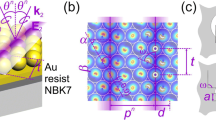Abstract
We predict an optical curtain effect, i.e., formation of a spatially invariant light field as light emerges from a set of periodic metallic nano-objects. The underlying physical mechanism of generation of this unique optical curtain can be explained in both the spatial domain and the wave-vector domain. In particular, in each period, we use one metallic nanostrip to equate the amplitudes of lights impinging on the openings of two metallic nanoslits and also shift their phases by π difference. We elaborate the influence on the output effect from some geometrical parameters like the periodicity, the slit height, and so on. By controlling the light illuminated on metallic subwavelength apertures, it is practical to generate optical curtains of arbitrary forms, which may open new routes of plasmonic nanolithography.





Similar content being viewed by others
References
Raether H (1988) Surface plasmons on smooth and rough surfaces and on gratings. Springer, New York
Xia Y, Halas N (2005) Shape-controlled synthesis and surface plasmonic properties of metallic nanostructures. MRS Bull 30:338–343
Volakis JL, Chatterjee A, Kempel JL (1998) Finite element method for electromagnetics. IEEE Press, New York
Ebbesen TW, Lezec HJ, Ghaemi HF, Thio T, Wolff PA (1998) Extraordinary optical transmission through sub-wavelength hole arrays. Nature 391:667–669
Fang NX, Lee H, Sun C, Zhang X (2005) Sub-diffraction-limited optical imaging with a silver superlens. Science 308:534–537
Maier SA (2007) Plasmonics: fundamentals and applications. Springer, New York
Koller DM, Hohenau A, Ditlbacher H, Galler N, Reil F, Aussenegg FR, Leitner A, List EJW, Krenn JR (2008) Organic plasmon-emitting diode. Nat Photon 2:684–687
Noginov MA, Zhu G, Belgrave AM, Bakker R, Shalaev VM, Narimanov EE, Stout S, Herz E, Suteewong T, Wiesner U (2009) Demonstration of a spaser-based nanolaser. Nature 460:1110–1112
Kabashin AV, Evans P, Pastkovsky S, Hendren W, Wurtz GA, Atkinson R, Pollard R, Podolskiy VA, Zayats (2009) Plasmonic nanorod metamaterials for biosensing. Nat Mater 8:867–871
Ferry VE, Sweatlock LA, Pacifici D, Atwater HA (2008) Plasmonic nanostructure design for efficient light coupling into solar cells. Nano Lett 8:4391
Levene MJ, Korlach J, Turner SW, Foquet M, Craighead HG, Webb WW (2003) Zero-mode waveguides for single-molecule analysis at high concentrations. Science 299:682–686
Tang L, Kocabas SE, Latif S, Okyay AK, Ly-Gagnon D-S, Saraswat KC, Miller DAB (2008) Nanometre-scale germanium photodetector enhanced by a near-infrared dipole antenna. Nat Photon 2(4):226–229
Lezec HJ, Degiron A, Devaux E, Linke RA, Martin-Moreno L, Garcia-Vidal FJ, Ebbesen TW (2002) Beaming light from a subwavelength aperture. Science 297:820
Sun Z, Kim HK (2004) Refractive transmission of light and beam shaping with metallic nano-optic lenses. Appl Phys Lett 85:642
Xie Y, Zakharian AR, Moloney JV, Mansuripur M (2004) Transmission of light through slit apertures in metallic films. Opt Express 12:6106–6121
Xie Y, Zakharian A, Moloney J, Mansuripur M (2005) Transmission of light through a periodic array of slits in a thick metallic film. Opt Express 13:4485–4491
Kobyakov A, Zakharian AR, Mafi A, Darmanyan SA (2008) Semi-analytical method for light interaction with 1D-periodic nanoplasmonic structures. Opt Express 16:8938–8957
Srituravanich W, Fang N, Sun C, Luo Q, Zhang X (2004) Plasmonic nanolithography. Nano Lett 4:1085
Shao DB, Chen SC (2006) Direct patterning of three-dimensional periodic nanostructures by surface-plasmon-assisted nanolithography. Nano Lett 6:2279
Wang CM, Chang YC, Tsai DP (2009) Spatial filtering by using cascading plasmonic gratings. Opt Express 17:6218–6223
He SL, Cui YX, Ye YQ, Zhang P, Jin Y (2009) Optical nanoatennas and metamaterials. Mater Today 12:16–24
Cui YX, Hu J, He SL (2009) Nanocavity antenna array assisted enhancing extraordinary optical transmission of light through a metallic nanoslit. J Opt Soc Am B 26:2131
Jeon S, Park JU, Cirelli R, Yang S, Heitzman CE, Braun PV, Kenis PJA, Rogers JA (2004) Fabricating complex three-dimensional nanostructures with high-resolution conformable phase masks. Proc Natl Acad Sci USA 101:12428–12433
Author information
Authors and Affiliations
Corresponding author
Rights and permissions
About this article
Cite this article
Cui, Y., Xu, J., He, S. et al. Plasmon-Assisted Optical Curtains. Plasmonics 5, 369–374 (2010). https://doi.org/10.1007/s11468-010-9152-9
Received:
Accepted:
Published:
Issue Date:
DOI: https://doi.org/10.1007/s11468-010-9152-9




